Basketball Old
Basketball – Click on Inductee to view Biography
1980
- Bob Anet - Basketball
-
1980
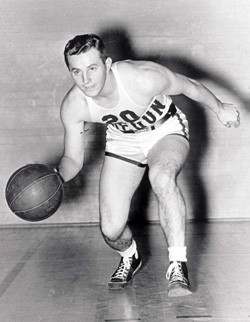 Robert “Bobby” Anet earned a spot in Oregon’s sporting lore through a standout career at both Astoria High School and the University of Oregon, where he captained the “Tall Firs” team that won the 1939 NCAA title.
Robert “Bobby” Anet earned a spot in Oregon’s sporting lore through a standout career at both Astoria High School and the University of Oregon, where he captained the “Tall Firs” team that won the 1939 NCAA title.Born in 1917, Anet attended Astoria High and helped the Fishermen win state titles in 1934 and ’35. As point guard, Anet helped the team develop an early version of the running game in the era when the center jump followed every basket. Astoria beat Jefferson of Portland 46-26 in the ‘35 title game, setting a record for most points in a title game. The record stood until 1943.
In Anet’s junior and senior seasons, Astoria finished a combined 68-8, including 39-4 in 1934-35. With scheduling restrictions, that record for wins will likely never be broken. The 5-foot-8 Anet played with Wally Johansen under coach John Warren, who guided the Fishermen to four titles in six years. Warren’s coaching skill led University of Oregon coach Howard Hobson, hired by the Ducks in 1935, to recruit him as the school’s freshman coach. Warren then recruited Anet and Johansen to Eugene.
At Oregon, Anet continued to develop a fastbreak style that became highly valuable when the center jump was abolished prior to the 1937-38 season. With Anet continuing to lead the offense primarily as a passer and not a scorer, the Ducks won the Pacific Coast Conference title in his senior season, 1938-39, with a 14-2 conference record and eventually finished 29-5, including three wins in the first NCAA Tournament. Oregon beat Ohio State 46-33 before 5,000 fans in the title game at Northwestern University with five players from Astoria High on its roster.
In addition scoring 10 points, Anet is also remembered for breaking the championship trophy while diving to save a loose ball in the title game.
Following his career at Oregon, Anet became a successful lumber broker and lived in Lake Oswego. He died of natural causes in 1981.
Oregon retired Anet’s number 20 following the 1939 season.
Anet was inducted into the Oregon Sports Hall of Fame as part of the inaugural class in 1980. He is also a member of the University of Oregon Athletics Hall of Fame.
- John Dick - Basketball
-
1980
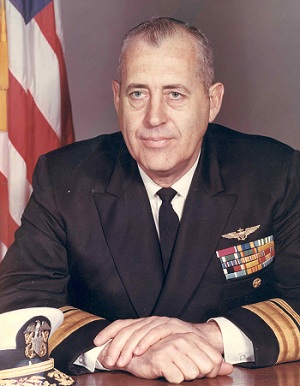 As a basketball player and later well-decorated member of the U.S. Navy, John Dick represented the state with a level of athletic skill and professional honor worthy of being remembered for all-time.
As a basketball player and later well-decorated member of the U.S. Navy, John Dick represented the state with a level of athletic skill and professional honor worthy of being remembered for all-time.Born in 1919, Dick grew up in The Dalles as part of an athletic family and caught the eye of Oregon coach Howard Hobson as a 6-foot-4 forward despite not having led the Indians farther than the first round of the state tournament. He moved to Eugene in 1936 and suited up for the varsity team as a sophomore the next season.
As a junior, he moved into the starting line-up and played a key role on the school’s NCAA Championship squad, the “Tall Firs.” Dick scored a game-high 13 points in the title game, a 46-33 win over Ohio State.
As the team returned via train to Eugene, hundreds of residents of The Dalles pooled change of any amount to purchase Dick a $75 watch to commemorate the title.
In 1940, the Ducks opened with seven wins in the first eight games, but finished 19-12 and missed the national playoffs. Dick earned a spot on the PCC Northern Division All-Conference First Team. In addition, he was named to the Helms Foundation All-America First-Team and the Converse Yearbook Second Team.
Dick enlisted in the Navy the day after the Japanese attack on Pearl Harbor, December 7, 1941, and eventually rose to the rank of Rear Admiral. He commanded the Supercarrier USS Saratoga for two years, 1967-69. He retired in 1973 after 32 years, returned to Eugene and became an Oregon season ticket holder with his wife.
Oregon’s basketball coaches annually present the John Dick Award to the team’s top defender.
Dick was inducted to the Oregon Sports Hall of Fame as part of the inaugural class in 1980 as a player, and in 1984 as part of the 1939 “Tall Firs.” The University retired his number, No. 18, and inducted him into its Athletic Hall of Fame in 1993.
- Dave Gambee - Basketball
-
1980
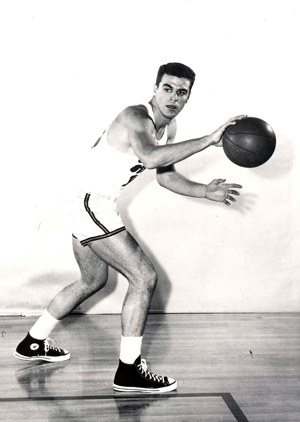 Dave Gambee went from Corvallis to a 12-year career in the NBA.
Dave Gambee went from Corvallis to a 12-year career in the NBA.
Born in Portland in 1937, he grew up in Corvallis and played at Oregon State as a 6-foot-6 forward from 1956-58. As a junior and senior, he was named an All-American, and helped the Beavers tie for the Pacific Coast Conference title in '58. They lost the PCC title game to California, 57-45. Gambee graduated from OSU as the career scoring leader at 18.9 points per game in 78 games.
The St. Louis Hawks drafted Gambee in the first round of the 1958 NBA Draft - seventh overall, and he played for the Hawks, and in Cincinnati, Syracuse, Philadelphia, San Diego, Milwaukee, Detroit and San Francisco.
In 12 years, he played 750 games and averaged 10.6 points and 5.2 rebounds per game. He was traded three times, had his contract sold twice and was selected twice in NBA Expansion drafts.
In 1967, Gambee played alongside Wilt Chamberlain with the Philadelphia 76ers, who won the NBA title.
Gambee was inducted to the Oregon Sports Hall of Fame as part of the inaugural class in 1980, and into the Oregon State Athletics Hall of Fame in 1991.
- Lauren "Laddie" Gale - Basketball
-
1980
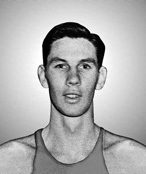 Lauren “Laddie” Gale played his way from Oakridge into state and national sports history through a standout basketball career at the University of Oregon, leading the Ducks in scoring on their way to the 1939 NCAA title.
Lauren “Laddie” Gale played his way from Oakridge into state and national sports history through a standout basketball career at the University of Oregon, leading the Ducks in scoring on their way to the 1939 NCAA title.Born in 1917, Gale grew to be 6-foot-4 as a senior and led Oakridge to the state semifinals in 1935, where the Oakers lost to eventual champion Astoria and standout guard Bobby Anet. Gale was voted to the All-Tournament First Team along with teammate Jake Fisher, and caught the attention of Astoria coach John Warren, who had led the Fishermen to four titles in six seasons. When Warren moved to Eugene following the season to join rookie head coach Howard Hobson, they recruited Gale.
At Oregon, Gale turned into an offensive force on three consecutive Pacific Coast Conference title teams, and helped lead the “Tall Firs” to a 29-5 record in 1939-39, when they won the first NCAA men’s basketball championship. Oregon beat Ohio State 46-33 in the title game in Evanston, Ill.
Gale led the PCC in scoring as both a junior and senior and is credited with helping develop the one-handed shot. He was named an All-American as a senior when he averaged 12 points per game.
Following the title season, Gale moved to the Detroit Eagles of the National Basketball League – a forerunner of the NBA, before being drafted into the Army at the start of World War II.
He played for several semi-pro teams following the war, but retired in 1949.
Gale was inducted into the Naismith Memorial Basketball Hall of Fame in 1977 and to the Oregon Sports Hall of Fame as part of its inaugural class in 1980. The “Tall Firs” were inducted as a team in 1984. The University of Oregon retired his number, No. 28, and inducted him into its Athletic Hall of Fame in 1993.
Gale died in 1996 at age 79.
- Ed Lewis - Basketball
-
1980
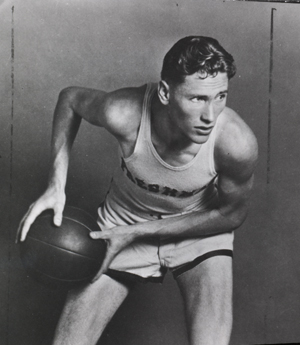 Ed Lewis made his mark on basketball at Oregon State from 1931-33, setting scoring records while leading the Beavers to their first Pacific Coast Conference title.
Ed Lewis made his mark on basketball at Oregon State from 1931-33, setting scoring records while leading the Beavers to their first Pacific Coast Conference title.
Lewis grew up in Portland and led WashingtonHigh School, coached by Eldon Jenne, to the state championship in 1928 and tournament semifinals in 1929 He earned a spot on the all-tournament first team each season. At 6-foot-5, he was one of the most heavily recruited players in the Northwest and chose to play at Oregon State.
In Corvallis, Lewis helped the Beavers, coached by Slats Gill, win the school's first Pacific Coast Conference title in 1932-33 and was named an All-American. The Oregon Journal in Portland selected him as the Northwest's top player of the first half-century in 1950.
Following graduation, Lewis played for the amateur Olympic Club team in San Francisco, then returned to the Willamette Valley and became a businessman and ardent supporter of OSU athletics.
In 1962, the school created the Ed Lewis Award in honor of the men's basketball player who provides the most team leadership.
Lewis was inducted to the Oregon Sports Hall of Fame as part of the inaugural class of 1980 and into the Oregon State Athletics Hall of Fame in 1988.
- Jim Loscutoff- Basketball
-
1980
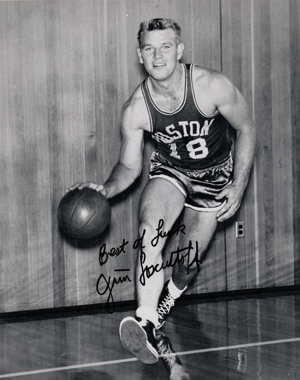 "Jungle Jim" Loscutoff carried the University of Oregon banner to the heights of the pro game by winning seven NBA titles with the Boston Celtics.
"Jungle Jim" Loscutoff carried the University of Oregon banner to the heights of the pro game by winning seven NBA titles with the Boston Celtics.
Loscutoff grew up in San Francisco, graduating from Palo Alto High in 1948. He didn't reach Oregon for two years, but developed into a 6-foot-5 standout forward at Oregon from 1951-55. He was named team MVP in 1955.
Although Oregon had just one winning season with Loscutoff on the roster, the Boston Celtics selected him fourth overall in 1955 and he played with the team for nine seasons, during which the team won seven NBA titles.
Following his retirement, Loscutoff became a teacher and then coach at Boston State College. He was inducted to the Oregon Sports Hall of Fame as part of the inaugural class in 1980.
- Ephraim "Red" Rocha - Basketbal
-
1980
 Ephraim “Red” Rocha helped put Oregon State on the basketball map as a standout player at both the college and professional levels before having a noteworthy career as a college coach.
Ephraim “Red” Rocha helped put Oregon State on the basketball map as a standout player at both the college and professional levels before having a noteworthy career as a college coach.Born in Hilo, Hawaii in 1923, Rocha grew to be 6-foot-9, but played most of his career weighing around 185 pounds, which earned him the nickname “The Thin Man.” Rocha graduated from Hilo High School and found his way to Oregon State, where he played under coach Slats Gill from 1944-47 and was an All-Pacific Coast Conference selection each season.
In 1946-47, the Beavers finished 28-5 overall and were the first OSU team to reach the NCAA Tournament. The team, nicknamed “The Thrill Kids” attracted such large crowds, the school was motivated to build the arena that became Gill Coliseum.
Rocha led the ’47 team in scoring and was named an All-American along with teammate Lew Beck, who later won a Gold Medal for the U.S. in the 1948 Olympic Summer Games.
Following the playoff run, Rocha turned pro and was selected by the Toronto Huskies with the 12th pick of the 1947 Basketball Association of America, which was in its second year. The Huskies folded before the season began and Rocha signed with the St. Louis Bombers.
In nine years as a professional, Rocha averaged 10.9 points and 6.6 rebounds per game while playing for four teams. He played in the 1951 and ’52 NBA All-Star Games, and helped lead the Syracuse Nationals to the 1955 NBA title.
Rocha is credited with being the only person born in Hawaii to have ever played in the NBA.
Rocha retired following the 1957 season with the Ft. Wayne Pistons, but became the team’s head coach midway through the ’57-58 season. He coached the Pistons, who had moved to Detroit during the offseason, for all or parts of the next two years before returning to Hawaii, where he became the head coach at the University of Hawaii in 1963.
At Hawaii, his teams won eight games or fewer six times in his first seven seasons, but responded with a 23-5 record and trip to the National Invitational Tournament in 1971, and 24-3 record and trip to the NCAA Tournament in ’72. He retired following a 15-11 campaign in ’73 with an overall record of 112-136.
Rocha helped found the Rainbow Classic, an eight-team college tournament that brings teams from the mainland to Hawaii, in 1964.
Rocha was inducted to the Oregon Sports Hall of Fame in 1980 and the OSU Athletics Hall of Fame in 1990. He is also a member of the University of Hawaii Sports Circle of Honor.
He died of cancer at age 86 in Corvallis in 2010.
- Algot "Swede" Westergren - Basketball
-
1980
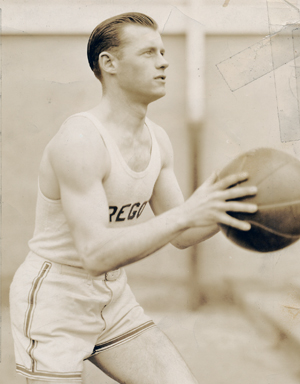 Algot "Swede" Westergren played three seasons at the University of Oregon, where he helped the squad to a combined 57-13 record, and was named All-Pacific Coast Conference at guard each season, 1924-27.
Algot "Swede" Westergren played three seasons at the University of Oregon, where he helped the squad to a combined 57-13 record, and was named All-Pacific Coast Conference at guard each season, 1924-27.
Westergren grew up in Astoria and led the Fishermen to the state tournament in 1922 and '23. They lost in the title game in '23. He was named first-team all-tournament both seasons.
As a senior, he helped Oregon celebrate the opening of McArthur Court with a 38-10 win over Willamette.
Westergren was inducted to the Oregon Sports Hall of Fame as part of the inaugural class of 1980 and into the University of Oregon Athletics Sports Hall of Fame in 1995.
- Urgel Slim" Wintermute - Basketball
-
1980
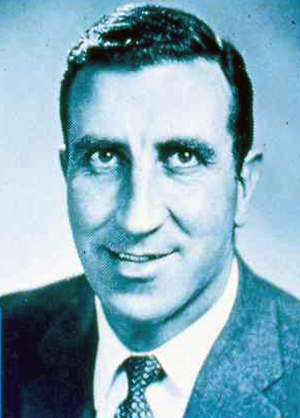 Urgel Wintermute earned the nickname slim thanks to his lean 6-foot-8 frame, and earned his way into Oregon lore thanks to his role in the University of Oregon’s NCAA Championship team of 1939.
Urgel Wintermute earned the nickname slim thanks to his lean 6-foot-8 frame, and earned his way into Oregon lore thanks to his role in the University of Oregon’s NCAA Championship team of 1939.Born in 1917, Wintermute grew up in Longview, Wash., and was recruited to Eugene by incoming coach Howard Hobson along with Wally Johansen, Bobby Anet and Laddie Gale, who played under freshman coach John Warren. Upon reaching the varsity team in 1936, the Ducks became the dominant team in the Pacific Coast Conference’s Northern Division, winning three consecutive division titles.
In 1939, Wintermute, whose size helped the Ducks earn the nickname “Tall Firs,” led the team to the first NCAA Tournament title.
Wintermute was voted All-America in 1938 and ’39.
After graduation, Wintermute played professionally for Detroit in the National Basketball League. In 1946, he became the player/coach of the Portland Indians in the Pacific Coast Basketball League whose roster included Ted Sarpola, a key reserve on the 1939 Oregon team, and former Oregon State standout John Mandic.
Following his playing career, he moved to Seattle and worked for Boeing.
Wintermute was inducted into the Oregon Sports Hall of Fame in 1980 and into the University of Oregon Athletics Hall of Fame in 1994.
1981
- Lew Beck - Basketball
-
1981
 Lew Beck carved out a remarkable career as an amateur athlete at Oregon State and beyond, including a spot on the 1948 U.S. Olympic team that won a gold medal. Born in Portland in 1922, Beck grew up as a standout player at the AAU level and found his way to Oregon State in 1942, where he played under legendary coach Slats Gill. He was a second-team pick for All-Pacific Coast Conference in 1943, before entering World War II as an engineer.
Lew Beck carved out a remarkable career as an amateur athlete at Oregon State and beyond, including a spot on the 1948 U.S. Olympic team that won a gold medal. Born in Portland in 1922, Beck grew up as a standout player at the AAU level and found his way to Oregon State in 1942, where he played under legendary coach Slats Gill. He was a second-team pick for All-Pacific Coast Conference in 1943, before entering World War II as an engineer.Following the war, Beck returned to Corvallis in 1946 and, along with teammates “Red” Rocha and Morrie Silver, helped lead the Beavers to a 28-5 record and trip to the 1947 NCAA Tournament, where they lost to Oklahoma 56-54 in the West Regional. Both Beck and Rocha were named All-Americans.
After the ’47 season, Beck bypassed professional basketball in favor of a business position with the Phillips ’66 Oil company, and a key role with the its AAU basketball team, the Phillips ‘66ers.
The ‘66ers, often referred to as the Oilers, won their sixth-straight AAU national title in 1948, then played the University of Kentucky in the final game of the Olympic Qualifying tournament before 18,475 fans on March 31 at New York’s Madison Square Garden. The ‘66ers won 53-49, which made Oilers coach Omar Browning the Olympic head coach. Kentucky coach Adolph Rupp served as assistant.
Browning named his starting five players, which included Beck, to the U.S. team. Rupp took his starting five players as well during the era when only amateur athletes competed in the Olympics.
The US team went unbeaten in seven games and won the Gold Medal Game 65-21 over France. Beck, who started the final along with the four other ‘66ers, averaged 4.7 points per game in the tournament, including six in the final.
Beck died in 1970 of cancer at age 47. Each year, the OSU basketball program selects its top newcomer for the Lew Beck Memorial Award.
Beck was inducted into the Oregon Sports Hall of Fame in 1981 and the OSU Athletics Hall of Fame in 1988.
- Cliff Crandall- Basketball
-
1981
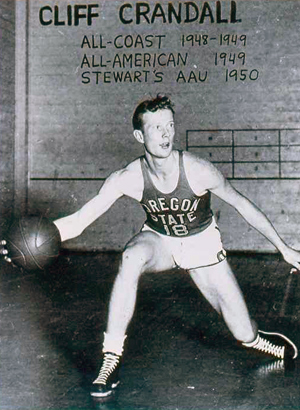 Cliff Crandall was a two-time All-American at Oregon State and led the Beavers to the NCAA Tournament West Region Final in 1949.
Cliff Crandall was a two-time All-American at Oregon State and led the Beavers to the NCAA Tournament West Region Final in 1949.Crandall grew up in Astoria, where he helped the Fishermen, coached by former Oregon State standout Wally Palmberg, reach the semifinals of the state tournament 1943, and was voted All-Tournament first team.
At Oregon State, he helped develop the concept of a small forward and was the first player to score 30 points in a game. He eventually set a school record for scoring with 1,250 points. In four seasons, Crandall missed just one of 127 games, establishing a program for games played that wasn’t surpassed until 2010.
The Beavers beat UCLA in a best-of three series in 1947 to win the Pacific Coast Conference title and reach the eight-team NCAA Tournament for the first time. They lost to No. 1 Oklahoma. Two years later, the Beavers won a tournament game for the first time to reach the regional final where they lost to Oklahoma A&M in what would now be the Final Four. That team played a consolation game, a loss to Illinois, which had lost the East Region final to Kentucky.
Crandall was named All-American in 1948 and ’49. He was drafted by the Minneapolis Lakers, but did not play professionally.
Crandall was inducted to the Oregon Sports Hall of Fame in 1981 and the Oregon State Athletics Hall of Fame in 1990.
- Eddie Durno - Basketball
-
1981
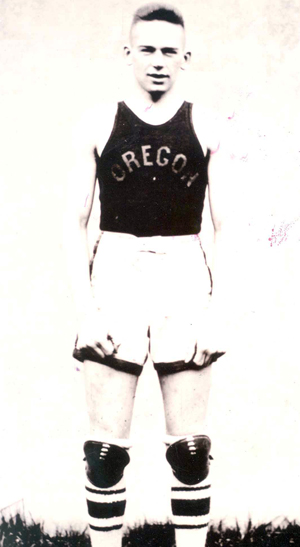 Eddie Durno helped establish the University of Oregon’s basketball legacy and later developed a political career that reached the United States Congress.
Eddie Durno helped establish the University of Oregon’s basketball legacy and later developed a political career that reached the United States Congress.Born in 1899, Durno grew up outside Albany, and served as an infantry sergeant during World War I. As a forward, he helped the Ducks win the Pacific Coast Conference title in 1919 and was named All-Conference along with teammate Hal Chapman. Durno, who also played football and baseball, earned that recognition the following two seasons and was named to the All-America team in 1921 by the Helms Foundation, which had created such a team the previous year.
Following graduation, Durno was a high school coach and then moved to Boston and earned a medical degree from Harvard. He became a physician in Boston until World War II. Durno served in the medical corps during the war and then returned to Oregon to establish a practice in Medford.
In 1958, Durno won election to the state senate and two years later was voted to the U.S. House of Representatives, where he served just one term. He ran for the U.S. Senate in 1962, but lost and returned to Medford.
He died in 1976 at age 77.
Durno was inducted to the Oregon Sports Hall of Fame in 1981 and the University of Oregon Athletics Hall of Fame in 1992.
- Wally Johansen - Basketbal
-
1981
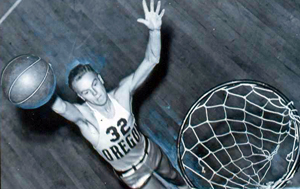 Wally Johansen played a key role in putting basketball in Astoria and then the University of Oregon on the state and national map.
Wally Johansen played a key role in putting basketball in Astoria and then the University of Oregon on the state and national map.Born in 1917, Johansen grew up in Astoria and found a role in the high school basketball program led by coach John Warren. Johansen, a 6-foot-2 guard, teamed with classmate and fellow guard Bobby Anet to help the Fishermen win the state title as juniors and seniors and then moved to Eugene to attend Oregon when Warren moved there to become an assistant coach.
At Oregon, Johansen developed his skills under Coach Howard Hobson and helped the Ducks win the Pacific Coast Conference Northern Division title in 1937, ’38 and ’39. The ’39 team won the PCC title after a best-of-three series victory over California, and won three games in the first NCAA men’s basketball tournament, including a 46-33 victory over Ohio State in the championship game. Johansen scored 9 points in the final.
Following his senior season and earning a degree, Johansen remained in Eugene and earned a Masters Degree from the University of Oregon School of Law. He eventually became a partner in a law firm in Coos Bay and served as President of the Oregon State Bar in 1967-68.
Johansen was inducted to the Oregon Sports Hall of Fame in 1981 and into the University of Oregon Athletics Hall of Fame in 1996
- Wally Palmberg - Basketball
-
1981
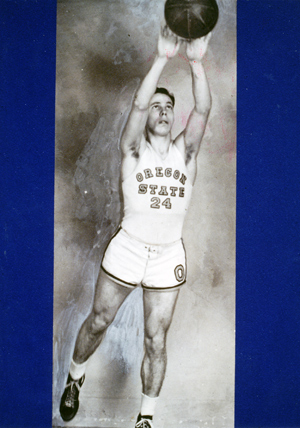 Wally Palmberg helped put both Astoria and Oregon State on the athletic map as and athlete, then returned to Astoria to continue the athletic program’s success as both a coach and author.
Wally Palmberg helped put both Astoria and Oregon State on the athletic map as and athlete, then returned to Astoria to continue the athletic program’s success as both a coach and author.Palmberg grew up in Astoria and was part of the high school’s first state championship team in 1930 under coach John Warren. He earned first-team all-tournament honors as a 5-foot-11 forward in 1931, when the Fishermen won the consolation trophy, then led the team to the ’32 title along with Bob Bergstrom.
At Oregon State, he helped the Beavers win the Pacific Coast Conference title as a junior, then averaged 11 points per game in 1936 and was named All-American after the team finished second in the PCC’s Northern Division.
Following graduation, Palmberg returned to Astoria and coached the basketball team to state titles in 1941 and ’42.
In 1993, Palmberg authored the book “Toward One Flag 1865-1943, a History of Lower Columbia Athletics.” He was inducted to the Oregon Sports Hall of Fame in 1981 and the Oregon State Athletics Hall of Fame in 1991.
- Charlie Warren - Basketball
-
1981
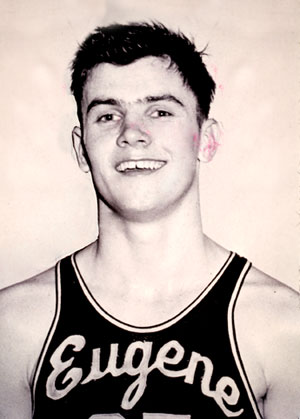 Charlie Warren played his way through Eugene from high school to the University of Oregon, eventually graduating from Mac Court as the schools all-time leading scorer.
Charlie Warren played his way through Eugene from high school to the University of Oregon, eventually graduating from Mac Court as the schools all-time leading scorer.Warren grew up in Eugene, the son of Oregon coach and future Oregon Sports Hall of Fame inductee John Warren, and helped Eugene High to the state tournament quarterfinals in 1956, and semifinals in ’57 as an athletic forward. During the ’57 season, he averaged 30 points per game.
At Oregon, Warren helped the Ducks reach the NCAA Tournament as a sophomore in 1960, where they played into the West Region final. Oregon again reached the tournament in 1961, where they lost in the first round.
During his senior season, Warren averaged 22.2 points per game, which remains among the school’s top season averages, and was voted to the All-America team despite the Ducks finishing 9-17. He finished his career with 1,301 points and 730 rebounds.
Following his career at Oregon, he entered the Army and became a successful businessman in Eugene.
Charlie Warren was inducted to the Oregon Sports Hall of Fame in 1981 along with his father.
Charlie Warren was inducted to the University of Oregon Athletics Hall of Fame in 1992 and the Pac-10 Conference Hall of Fame in 2011.
1982
- Jim Barnett - Basketball
-
1982
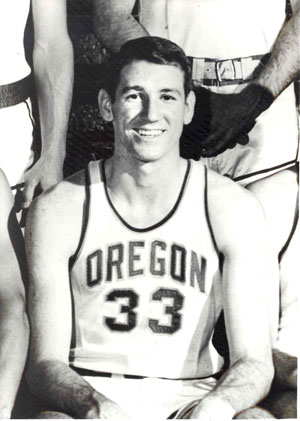 Jim Barnett made his mark on Oregon as a durable, feisty player at both the University of Oregon and in the NBA, including one memorable season with the Portland Trail Blazers.
Jim Barnett made his mark on Oregon as a durable, feisty player at both the University of Oregon and in the NBA, including one memorable season with the Portland Trail Blazers.Born in 1944 in South Carolina, Barnett grew up in Riverside, Calif., and was recruited from Ramona High by the University of Oregon as a 6-foot-4 guard and small forward. Barnett, who chose Oregon over UCLA because he envisioned more playing time in Eugene, played at McArthur Court from 1963 through ’66 and finished as the Ducks all-time leading scorer having averaged 17.7 points per game. He was an All-American in 1966 and played in the NABC East-West All-Star Game.
The Boston Celtics selected him with the eighth pick of the 1966 NBA Draft, and the San Diego Rockets selected him the following season in the NBA Expansion Draft. After three seasons in San Diego, the Blazers acquired him prior to its expansion season in 1970.
In Portland, he recorded the Blazers first triple-double, with 27 points, 10 rebounds and 12 assists on Dec. 1, 1970, against the Rockets. He is credited with inspiring broadcaster Bill Schonely to create the term “Rip City” during a game in 1971.
During his 11-year NBA career, Barnett played for seven teams: Boston, San Diego, Portland, San Francisco, New Orleans, New York and Philadelphia, and played in 70 or more games eight times. His teams reached the playoffs five times, including the Eastern Conference finals with Boston in 1967 and Western Conference finals with Golden State in 1973. He averaged 11.7 points per game during his career, and retired at age 32.
Barnett averaged a career-best 18.5 points per game during his season in Portland.
After retiring at age 32, Barnett worked in the advertising and sales promotion field for a decade before leaving to become co-host of a popular pre-game show for the Golden State Warriors.
He was inducted to the University of Oregon Athletic Hall of Fame in 1994 and the Oregon Sports Hall of Fame in 1982.
- Mel Counts - Basketball
-
1982
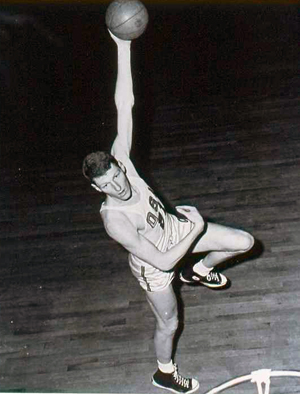 Mel Counts had one of the most storied basketball careers for a player from the Coast, moving from Marshfield High to Oregon State to 12 years in the National Basketball Association. And, he won a Gold Medal.
Mel Counts had one of the most storied basketball careers for a player from the Coast, moving from Marshfield High to Oregon State to 12 years in the National Basketball Association. And, he won a Gold Medal.Born in 1941, Counts grew up in Coos Bay and excelled in basketball as a 7-foot center. The Pirates reached the state title game in 1959 and ’60, but lost each time.
At Oregon State, Counts played three varsity seasons: 1962-64, and led the Beavers to the NCAA Tournament each season, including the Final Four in 1963. The Beavers were a combined 71-18 in those seasons. Counts averaged 21.3 points and 15.6 rebounds per game as a junior and 26.7 points and 18.9 rebounds per game as a senior and was voted All-American both seasons.
In 1964, Counts played on the U.S. team that won the gold medal in the Olympic Summer Games, shortly after the Boston Celtics had taken him with the seventh pick of the NBA Draft.
Counts won the NBA title with the Celtics in his first two seasons playing as a reserve to Bill Russell. He later played with the Baltimore Bullets, Los Angeles Lakers, Phoenix Suns, Philadelphia 76ers and New Orleans Jazz. He reached the NBA Finals four times with the Lakers.
In 12 seasons, Counts averaged 8.3 points and 6.0 rebounds per game.
Counts was inducted to the Oregon Sports Hall of Fame in 1982 and into the Oregon State Athletics Hall of Fame in 1988.
- Hugh "Hunk" Latham - Basketball
-
1982
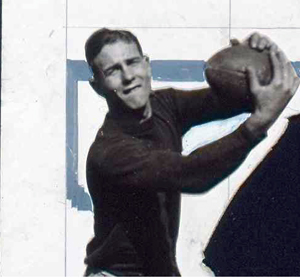 Hugh "Hunk" Latham played three sports at theUniversity of Oregon and helped the basketball program develop a following that created McArthur Court.
Hugh "Hunk" Latham played three sports at theUniversity of Oregon and helped the basketball program develop a following that created McArthur Court.
Latham played four seasons of baseball and football, but neither team found success like the basketball team. In Latham's three seasons (1921, 22-24), the Ducks were a combined 45-25, which caused attendance to rise and students to lobby for a modern basketball facility. The student body voted to tax itself $15 per year in order to pay for capital projects on campus, one of which was an indoor arena it named after Clifton McArthur, the school's first Student Body President. The gym opened in October of 1926.
Latham was inducted to the Oregon Sports Hall of Fame in 1982.
- John Mandic- Basketball
-
1982
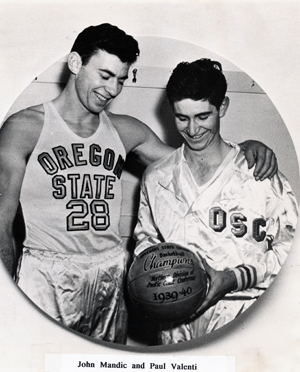 John Mandic helped Oregon State to a pair of Pacific Coast Conference titles and was the first player to be named to the PCC Northern Division first-team in three seasons.
John Mandic helped Oregon State to a pair of Pacific Coast Conference titles and was the first player to be named to the PCC Northern Division first-team in three seasons.
Born in 1919 in Los Angeles, Mandic grew to 6-foot-4 and found his way to Corvallis, where he helped the Beavers to PCC Northern Division titles in 1940 and '42. They lost to the Southern Division champion in both title seasons. In '42, Mandic was named All-American. In his three varsity seasons the Beavers were a combined 64-29.
Following graduation and World War II, Mandic played professionally with the Portland Indians, the Rochester Royals and then two seasons with three different teams in the Basketball Association of American and NBA from 1948-50.
Mandic was inducted to the Oregon Sports Hall of Fame in 1982 and the Oregon State Athletics Hall of Fame in 1991.
- Jack Riley - Basketball
-
1982
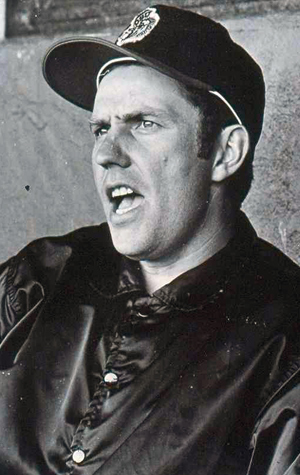 Jack Riley is better known for his baseball accomplishments, but he made a significant impact on the basketball program at Linfield College.
Jack Riley is better known for his baseball accomplishments, but he made a significant impact on the basketball program at Linfield College.
Born in 1938, Riley grew up in Portland and attended Grant High, which had only made the state tournament once since 1926 and did not while he played there. But, his skill at guard caught the attention of numerous schools in the Northwest, including Washington State.
Riley chose to play at Linfield to be closer to home and a "big fish in a small pond." He played there from 1956-60 and Linfield won the NAIA's Northwest Conference title each season, advancing to the national tournament in 1959. Riley led the conference in scoring as a sophomore, junior and senior and was twice named All-American.
Riley also played baseball and led Grant to the state playoffs in 1956. Following graduation, he played on several semi-pro teams before heading to Linfield, where he was a three-time All-Conference outfielder.
Riley played two seasons in the Northwest League with Salem before closing out his professional career. He then turned to coaching, becoming head coach at Portland's Jefferson High in 1962. Riley moved to Lower Columbia College from 1967-72, when he was hired as head coach at Oregon State.
In Corvallis, Riley guided the Beavers for 22 seasons (1973-94), compiling a record of 613-411-5, which established a school record. The Beavers won five Pac-10 Northern Division titles and reached the NCAA playoffs three times.
Riley was inducted to the Oregon Sports Hall of Fame in 1982.
1983
- Mark "Buck" Grayson - Basketball
-
1983
 Mark “Buck” Grayson was a three-sport athlete at Jefferson High, who starred at Oregon State and then had a distinguished career as a city commissioner in Portland.
Mark “Buck” Grayson was a three-sport athlete at Jefferson High, who starred at Oregon State and then had a distinguished career as a city commissioner in Portland.Grayson played football, basketball and baseball at Jefferson, then moved to Oregon State for coach Slats Gill's first three season: 1928-1931. At OSU, he helped the team to winning records in each season and was selected a second-team All-American by College Humor Magazine in 1930.
In 1958, Grayson won a primary election of 18 candidates and the general election to become Portland's Commissioner for Position 2. He served until 1970.
He was inducted to the Oregon Sports Hall of Fame in 1983.
1984
- Geoff Petrie - Basketball
-
1984
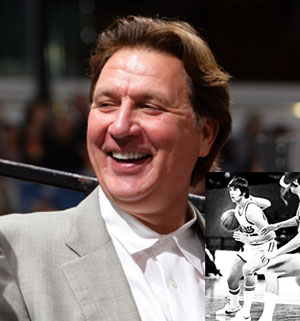 Geoff Petrie will forever be remembered as the first star of the Portland Trail Blazers, helping build the team’s identity before it won the World Championship in 1977.
Geoff Petrie will forever be remembered as the first star of the Portland Trail Blazers, helping build the team’s identity before it won the World Championship in 1977.Born in 1948, Petrie grew up in Pennsylvania, and then attended Princeton University, where he was one of the top players in the Ivy League from 1967-70. He helped the Tigers reach the NCAA Tournament in 1969 when he averaged 23.9 points per game. Portland made Petrie, a 6-foot-4 shooting guard, the first of its 19 draft picks (eight overall) during its expansion season, 1970-71, and he responded by being named NBA Rookie of the Year along with Dave Cowens of the Boston Celtics. Petrie averaged 24.8 points during the season and also earned a spot on the 1971 Western Conference All-Star Team.
In his six seasons with the Blazers, Petrie averaged 24 points per game per season three times and was selected to play in the 1974 All-Star Game. He played in 446 games during his years in Portland and averaged 21.8 points. He set the team record for scoring at 51 points, twice in 1973 (both times against the Houston Rockets), a record that stood until 2005, when Damon Stoudamire scored 54. Petrie scored 40 or more points in a game 13 times.
The Blazers traded Petrie to the Atlanta Hawks for the second pick in the ABA Dispersal Draft following the 1975-76 season, but he retired before playing any further games due to a knee injury. The Blazers used the draft pick to select Maurice Lucas.
Petrie rejoined the Blazers in 1985 and rose to Senior Vice President of Operations before being hired by the Sacramento Kings in 1994 as President of Basketball Operations. The NBA named Petrie Executive of the Year in 1999 and 2001.
The Blazers retired Petrie’s number (45). He was inducted to the Oregon Sports Hall of Fame in 1984.
1985
- Dave Twardzik - Basketball
-
1985
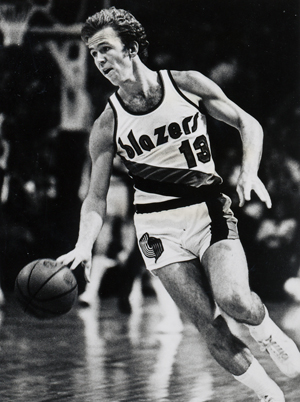 Dave Twardzik worked his way into the hearts of Oregonians as a scrappy guard, who started for the 1977 Trail Blazers NBA Champion team.
Dave Twardzik worked his way into the hearts of Oregonians as a scrappy guard, who started for the 1977 Trail Blazers NBA Champion team.Twardzik grew up in Pennsylvania and played at Old Dominion University, an NCAA Div. II school at the time. He helped the team to the 1971 NCAA Tournament title game and was selected by the Blazers in the ’72 NBA Draft, but chose to play for the Virginia Squires of the American Basketball Association. In his first season, he played alongside Julius Erving and George Gervin.
Twardzik was an All-Star in 1975, and signed with Portland shortly after the NBA and ABA merged in 1976.
In Portland, he became part of the team’s memorable pack of guard-forwards along with Bob Gross, Lionel Hollins and Larry Steele – a group that backed up a frontline of Bill Walton and Maurice Lucas.
Following the 1977 title season, Twardzik played three more seasons in Portland and retired with career averages of 9.3 points and 3.4 assists per game. He became a coach and then executive with several NBA teams, including general manager of the Orlando Magic.
Twardzik was inducted to the Oregon Sports Hall of Fame in 1985.
1987
- Jim Jarvis - Basketball
-
1987
 Jim Jarvis helped the Oregon State men’s basketball team reach the NCAA Tournament Final Four in 1963, played professionally and then coached at the Division I level.
Jim Jarvis helped the Oregon State men’s basketball team reach the NCAA Tournament Final Four in 1963, played professionally and then coached at the Division I level.Jarvis grew up in Southern Oregon, earning All-Tournament first-team honors in 1959 at Coquille when the Red Devils reached the semifinals, and in 1961 at Roseburg, which reached the quarterfinals. His father, Curt, coached both teams.
Jarvis played at Oregon State under legendary coach Slats Gill, and was a sophomore on the 1962-63 team that won the NCAA West Regional before losing to top-ranked Cincinnati and second-ranked Duke in the Final Four. The following season, Jarvis averaged 13.8 points per game as the Beavers, led by Mel Counts, entered the NCAA Tournament at 25-3, but were upset by Seattle 61-57 in the first round by Idaho at McArthur Court. Jarvis averaged 21.1 points and 4.3 rebounds in 1964-65 and was named an All-American, but the Beavers finished 16-10 and were left out of the tournament.
Professionally, he averaged 5.8 points per game during two seasons in the American Basketball Association.
Jarvis went into the coaching ranks, and, after a successful stint at Spokane Falls Community College, was hired by Idaho in 1974 and spent four seasons there.
Jarvis was inducted into the Oregon Sports Hall of Fame in 1987 and the Oregon State Athletics Hall of Fame in 1991.
1988
- Richard Washington - Basketball
-
1988
Richard Washington played his way from the streets of Portland into the basketball machine at UCLA and then into the NBA, where he remains the highest draft pick of a native Oregonian.
Born in 1955, Washington attended Benson High, where he played under coach Dick Gray. Washington grew to be a 6-foot-11 center and led the Techmen to the state title in 1971 and ’73, and fourth place in 1972 when rival Jefferson won the state title.
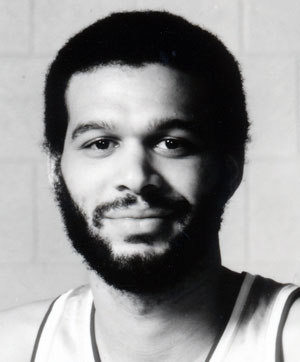 Washington was voted to the all-tournament first team all three seasons. In those three seasons, the Techmen were a combined 77-6.
Washington was voted to the all-tournament first team all three seasons. In those three seasons, the Techmen were a combined 77-6.As one of the nation’s most recruited players, Washington chose to attend UCLA, which won its ninth title in the previous 10 years in ’73 with center Bill Walton earning the NCAA Tournament’s Most Outstanding Player award for the second straight year.
UCLA reached the NCAA Tournament’s Final Four in Washington’s three seasons at the school, but lost in the semifinals in ’74 and ’76.
In ’75, Washington led the Bruins to the NCAA title and earned the Tournament’s Most Outstanding Player award. He was voted to the All-America First Team. After the title game, coach John Wooden retired having led the program to 10 titles in his final 12 years.
Following the ’76 Tournament, Washington used the NBA Hardship Exception, which allowed him to be drafted with a year of college eligibility remaining. The Kansas City Kings selected him third overall and he averaged 13.0 points and 8.5 rebounds per game as a rookie.
Washington averaged 12.8 points and 8.4 rebounds in his second year, but played just 18 game due to injury in his third season and was limited to being a role player for the following three seasons. He was a member of the Dallas Mavericks during their expansion season, 1980-81. He retired in 1982.
In six seasons in the NBA, Washington played in 351 games and averaged 9.8 points and 6.3 rebounds per game. He played in 11 playoff games.
Washington, who returned to Portland and started a construction company, was inducted into the Oregon Sports Hall of Fame in 1988.
1990
- Steve Jones - Basketball
-
1990
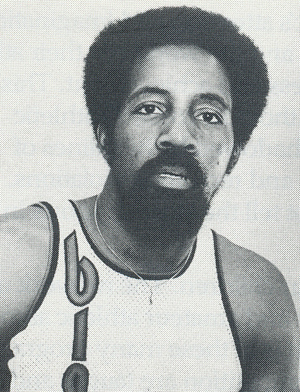 Steve Jones earned his place in Oregon sports lore as a basketball player at the high school, college and professional level and then as a broadcaster, where he earned the nickname "Snapper."
Steve Jones earned his place in Oregon sports lore as a basketball player at the high school, college and professional level and then as a broadcaster, where he earned the nickname "Snapper."
Born in Louisiana, Jones grew up in Portland and helped Franklin High to the 1959 state title. He moved to Eugene and played forward at Oregon from 1961-64. He scored a school record 37 points in '63 and was named team MVP as a junior and senior, when he was also named first-team all-conference.
Jones reached the pro level three years later, when the American Basketball Association began play. He signed with the Oakland Oaks in 1967 and played eight years in the league, earning an All-Star berth three times. He played in six other cities following his rookie year in Oakland and averaged 16.0 points per game.
Jones finally moved to the NBA for the 1975-76 season when he signed with the Portland Trail Blazers at age 33.
Jones played just one season in Portland before retiring and becoming a color commentator for Blazers games as well as regularly handling the same duties for games broadcast nationally on CBS. Jones continued working as a color commentator for networks that carried NBA games and was part of the broadcast team that covered "The Dream Team" at the 1992 Barcelona Summer Olympic Games.
Jones was inducted to the Oregon Sports Hall of Fame in 1990 and University of Oregon Athletics Hall of Fame in 1993.
1993
- Carol Menken-Schaudt - Basketball
-
1993
 Carol Menken-Schaudt from Jefferson, Oregon arrived at Oregon State University, via Linn-Benton Community College, with no fanfare, but became one of the greatest players in Oregon Basketball history. In the 1984 Los Angeles Olympics, as the starting center she led the U.S. team to Gold Medal. At OSU she was selected as the MVP in 1979 and 1980. In 1981, she was the national college leader in field goal percentage (.750) and fourth in scoring (29.6 average).
Carol Menken-Schaudt from Jefferson, Oregon arrived at Oregon State University, via Linn-Benton Community College, with no fanfare, but became one of the greatest players in Oregon Basketball history. In the 1984 Los Angeles Olympics, as the starting center she led the U.S. team to Gold Medal. At OSU she was selected as the MVP in 1979 and 1980. In 1981, she was the national college leader in field goal percentage (.750) and fourth in scoring (29.6 average). She leads the OSU career record book in free throws made (333), free throws attempted (551), field goals made (955). Field goal percentage (.692), rebounds (901), career scoring average (27.7), and total points (2243). Carol and her husband Ken live in Corvallis.
- Bill Walton - Basketball
-
1993
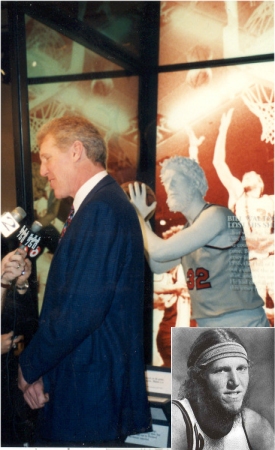 Bill Walton led UCLA to two NCAA titles before arriving in Memorial Coliseum to join an average Portland Trail Blazer team. Walton emerged as one of the greatest basketball players in Portland Trail Blazer and NBA history. Walton led the Blazers to the NBA Championship in 1977 with dramatic performances in the title series. In the championship game he had 20 points, 7 assists, 23 rebounds and a record 8 blocked shots in the 109-107 victory over Philadelphia 76ers.
Bill Walton led UCLA to two NCAA titles before arriving in Memorial Coliseum to join an average Portland Trail Blazer team. Walton emerged as one of the greatest basketball players in Portland Trail Blazer and NBA history. Walton led the Blazers to the NBA Championship in 1977 with dramatic performances in the title series. In the championship game he had 20 points, 7 assists, 23 rebounds and a record 8 blocked shots in the 109-107 victory over Philadelphia 76ers. Drafted No. 1 in the nations in 1974, Walton was MVP in the 1978 regular NBA season. He was selected as an NBA All-Star in 1977 and 1978. Beyond the numbers, Walton was a clutch player and a winner who enabled his Blazer team to accomplish one of the greatest achievements in Oregon’s sports history.
1995
- Steve Johnson - Basketball
-
1995
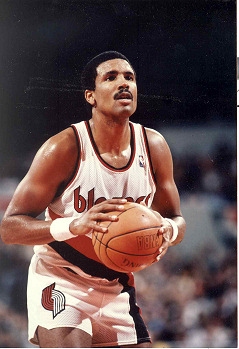 A 6-foot 10-inch Oregon State University basketball star from 1977-1981, Steve Johnson was second at OSU for career points (2,035) and career field goals (828). A 1st Team Consensus All-America and Pac-10 Player of the Year in 1981, Steve was also a three time selection as All Pac-10. As a senior, he led the Pac-10 in scoring with a 21-point average. His 1981 .746 field goal percentage is an NCAA single season record and Johnson’s .678 Career field goal percentage ranks 2nd all time in the NCAA and is a Pac-10 record.
A 6-foot 10-inch Oregon State University basketball star from 1977-1981, Steve Johnson was second at OSU for career points (2,035) and career field goals (828). A 1st Team Consensus All-America and Pac-10 Player of the Year in 1981, Steve was also a three time selection as All Pac-10. As a senior, he led the Pac-10 in scoring with a 21-point average. His 1981 .746 field goal percentage is an NCAA single season record and Johnson’s .678 Career field goal percentage ranks 2nd all time in the NCAA and is a Pac-10 record. As a professional player, Steve was the 1st round draft pick of the Kansas City Kings in 1981. His playing career brought him to the Portland Trail Blazers (1986-1989) and he was named Blazer MVP in 1987. Steve finished his Blazer career with 1,048 field goals (.540), 1,166 rebounds, 317 assists, 617 free throws (.627) and 2,713 points (14 ppg.) Steve capped his NBA career with 2,841 field goals (.572), 3,450 rebounds and 7,345 points.
1996
- Greg Ballard - Basketball
-
1996
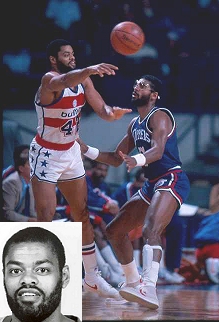 A four-year starter at the University of Oregon, Greg Ballard twice won All-conference honors and was All-American forward in 1977 when he averaged 26.7 points and 9.8 rebounds per game. He led the Pac-8 Conference in scoring twice and helped the Ducks to a 74-41 record and three NIT appearances from 1974-77.
A four-year starter at the University of Oregon, Greg Ballard twice won All-conference honors and was All-American forward in 1977 when he averaged 26.7 points and 9.8 rebounds per game. He led the Pac-8 Conference in scoring twice and helped the Ducks to a 74-41 record and three NIT appearances from 1974-77.Ballard ranks as Oregon’s career leader in rebounds (1,114), is third in scoring (1,829), and set a school record with 43 points in one game. A first round draft choice of the Washington Bullets, he was a member of their world championships team in 1978 and finished his NBA career with 9,953 points (12.4 per game) in 10 seasons.
1997
- Charlie Sitton - Basketball
-
1997
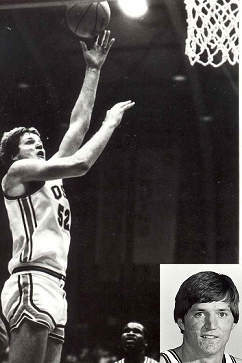 As a McMinnville Grizzly, Sitton earned All-State basketball honors three times and was first team prep All-American in his senior year. The Grizzlies won the state AAA title in 1979. Sitton was named MVP of the United States All-Stars in the Capital Classic in Washington D.C., and played in McDonald’s annual prep All-American game in Oakland.
As a McMinnville Grizzly, Sitton earned All-State basketball honors three times and was first team prep All-American in his senior year. The Grizzlies won the state AAA title in 1979. Sitton was named MVP of the United States All-Stars in the Capital Classic in Washington D.C., and played in McDonald’s annual prep All-American game in Oakland.Sitton was a four-year starter for the Beavers, leading them to a 93-25 record during his college career. He was a two time All-American (1983-84), three-time All-Pac-10 selection (1982-84). He played in three NCAA tournaments and one National Invitational Tournament. After college, Sitton was drafted by the Dallas Mavericks.
1998
- Jim Boutin - Basketball
-
1998
 From Powers, Oregon Jim Boutin went on to an outstanding college basketball career at Lewis & Clark College where he was a four-year starter (1961-64) and earned All-American honors. Boutin led the Pioneers to three consecutive NW Conference basketball titles (1962-1964) and three consecutive appearances in the NAIA National Tournament. As a senior, he was 1st Team NAIA All-American, averaging 30.2 points per game, 14.8 rebounds per game and finished seventh in the nation in scoring. He also was 1st Team All-American as a junior and 3rd Team All-American as a sophomore. Boutin is Lewis & Clark’s single season and career scoring leader (2,218 points; 20.1 average) and is second in career rebounds (1,298; 13.2 average). He was inducted into the NAIA Hall of Fame in 1990. Boutin was drafted by the New York Knicks in 1965.
From Powers, Oregon Jim Boutin went on to an outstanding college basketball career at Lewis & Clark College where he was a four-year starter (1961-64) and earned All-American honors. Boutin led the Pioneers to three consecutive NW Conference basketball titles (1962-1964) and three consecutive appearances in the NAIA National Tournament. As a senior, he was 1st Team NAIA All-American, averaging 30.2 points per game, 14.8 rebounds per game and finished seventh in the nation in scoring. He also was 1st Team All-American as a junior and 3rd Team All-American as a sophomore. Boutin is Lewis & Clark’s single season and career scoring leader (2,218 points; 20.1 average) and is second in career rebounds (1,298; 13.2 average). He was inducted into the NAIA Hall of Fame in 1990. Boutin was drafted by the New York Knicks in 1965. Him went on to an outstanding basketball coaching career. His coaching tenure included Portland’s Washington High School (39-12), Willamette University (194-130), Western Oregon State (143-43), Idaho State (45-41) and currently coaches at Lane Community College. He earned his 500th career coaching victory in January 1997.
- Ron Lee - Basketball
-
1998
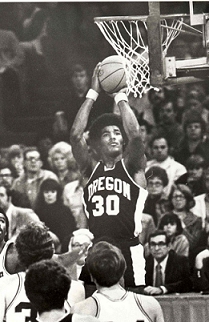 As a University of Oregon Duck, Ron Lee was the first player ever named to the Pac-8 All conference team for four consecutive years (1973-76) and was the 1976 Pac-8 Player of The Year. As a starting guard, Lee was selected four times as Oregon’s Most Valuable Player and was the Duck’s scoring leader for four straight years. Lee joined the Ducks after they had a 6-20 season (1971-72) and led Oregon to a 71-41 record and two NIT appearances in the next four years. He was the second player in conference history to score 2,000 career points and is the University of Oregon’s career scoring leader with 2,085 points and 18.6 average per game. In 1975 he was selected 2nd team consensus All-American and received All-American recognition in 1971 and 1972. Aside from “The Tall Firs,” he is the only Oregon basketball player to have his jersey (#30) retired by the school. After graduating, Lee played six NBA seasons (Phoenix, New Orleans, Atlanta and Detroit), averaging 7.3 points and 3.8 assists per game (1976-1982).
As a University of Oregon Duck, Ron Lee was the first player ever named to the Pac-8 All conference team for four consecutive years (1973-76) and was the 1976 Pac-8 Player of The Year. As a starting guard, Lee was selected four times as Oregon’s Most Valuable Player and was the Duck’s scoring leader for four straight years. Lee joined the Ducks after they had a 6-20 season (1971-72) and led Oregon to a 71-41 record and two NIT appearances in the next four years. He was the second player in conference history to score 2,000 career points and is the University of Oregon’s career scoring leader with 2,085 points and 18.6 average per game. In 1975 he was selected 2nd team consensus All-American and received All-American recognition in 1971 and 1972. Aside from “The Tall Firs,” he is the only Oregon basketball player to have his jersey (#30) retired by the school. After graduating, Lee played six NBA seasons (Phoenix, New Orleans, Atlanta and Detroit), averaging 7.3 points and 3.8 assists per game (1976-1982).
- Jim Paxson - Basketball
-
1998
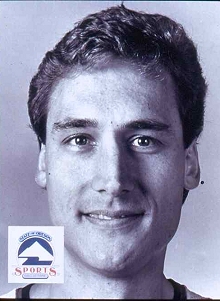 For eight full seasons (1979-1988), Jim Paxson was an integral part of the Portland Trail Blazers. The Trail Blazers made Paxson their first selection (12th overall) in the 1979 draft. In the next nine seasons, he played in 627 games, the team’s fifth highest total ever and is one of only four players to ever score more than 10,000 points in a Blazer uniform. He was an All-NBA second team selection in 1984 and twice represented Portland in NBA All-Star Games (1983 and 1984).
For eight full seasons (1979-1988), Jim Paxson was an integral part of the Portland Trail Blazers. The Trail Blazers made Paxson their first selection (12th overall) in the 1979 draft. In the next nine seasons, he played in 627 games, the team’s fifth highest total ever and is one of only four players to ever score more than 10,000 points in a Blazer uniform. He was an All-NBA second team selection in 1984 and twice represented Portland in NBA All-Star Games (1983 and 1984). On the All-Time Blazer career record list, Paxson is 5th in total points (10,003), 5th in assists (2,007), 3rd in field goals (4,058), 6th in free throw percentage (.804) and 4th in steals (857). Jim came to Portland from the University of Dayton where he averaged 18 points per game and was named al All-American in 1979 by the U.S. Basketball Writer’s Association. Jim returned to Portland after finishing his NBA career with the Boston Celtics and currently is assistant General Manager for the Portland Trail Blazers.
1999
- Danny Ainge - Basketball
-
1999
 Danny Ainge is recognized as one of Oregon’s finest all-around prep athletes. A three-sport star, he earned First Team All-State honors in basketball (twice), football and baseball at North Eugene High School. A four-year starter at Brigham Young University, Ainge earned All-American honors and won the Wooden Award as the top player in college basketball in 1981.
Danny Ainge is recognized as one of Oregon’s finest all-around prep athletes. A three-sport star, he earned First Team All-State honors in basketball (twice), football and baseball at North Eugene High School. A four-year starter at Brigham Young University, Ainge earned All-American honors and won the Wooden Award as the top player in college basketball in 1981. He played 14 seasons in the NBA, winning NBA Championships with the Boston Celtics in 1984 and 1986. Ainge played for four NBA teams, including the Portland Trail Blazers (1990-92). NBA career statistics include: 1,042 games, 11,964 points, 2,768 rebounds and 4,199 assists. He also averaged 11.5 points, 2.7 rebounds and 4.0 assists per game. In 1996 Ainge became the Phoenix Suns head coach.
2000
- Maurice Lucas - Basketball
-
2000
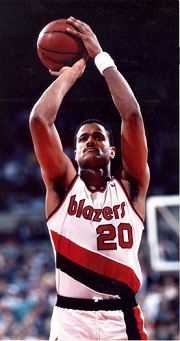 Maurice Lucas was the prototype power forward of his day. Many Portland Trail Blazer fans remember him as a player of considerable size and strength who earned a reputation as on of basketball’s original “enforcers.” Lucas, who averaged 18 points and 10 rebounds per game in his three and a half years with the Blazers, succeeded not only with intimidation but with excellent offensive skills and a soft shooting touch.
Maurice Lucas was the prototype power forward of his day. Many Portland Trail Blazer fans remember him as a player of considerable size and strength who earned a reputation as on of basketball’s original “enforcers.” Lucas, who averaged 18 points and 10 rebounds per game in his three and a half years with the Blazers, succeeded not only with intimidation but with excellent offensive skills and a soft shooting touch. An outstanding player at Marquette University, Lucas left the school after his junior year to join the NBA rival American Basketball Association (ABA). After the ABA folded in 1976, Portland was able to select Lucas in the dispersal draft with the second pick after trading Geoff Petrie and Steve Hawes to Atlanta. Lucas’ best NBA seasons were spent in Portland where he had three straight All-Star years and helped lead the Trail Blazers to their only NBA Championship in franchise history.
During that glorious 1976-77 season, Lucas made his first trip to the NBA All-Star Game by averaging 20.2 points, 11.4 rebounds and, according to the New York Times, “2.3 welts across his opponents chests per game.” As former Blazer teammate Lionel Hollins said during a toast to Lucas: “To Luke, Basketball was a contact sport. All con and no tact. “ With Lucas serving as Bill Walton’s inside muscle, the Blazers finished second in the Pacific Division and marched through the playoffs to meet the Philadelphia 76ers in the NBA Finals. After losing the first two games of the series, Lucas helped shout down 76er power forward George McGinnis and intimidated Darryl Dawkins “into oblivion.” Portland went on to become only the second team in NBA history to come back from a 2-0 deficit to win four straight games for the championship.
In Lucas’ next two seasons with Portland, he made the All-Star team and established himself as one of the best power forwards in the game by averaging 20 points and 10 rebounds per game in 1978-79. Lucas also excelled off the court, serving seven years as the NBA Player’s Association Vice President and receiving the NBA Spirit of Love Award for Community Involvement. He is a member of the Trail Blazers Ring of Honor and after retiring from the NBA in 1988 he resided in Portland.
2001
- Clyde Drexler - Basketball
-
2001
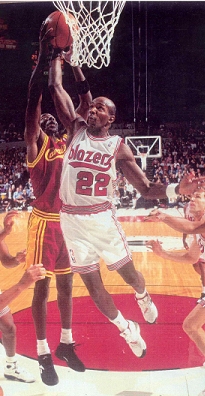 As a 6-foot-7-inch guard, Clyde Drexler captured the hearts of Portland Trailblazer fans. During his 15 years in the NBA, Drexler set a unique standard. The athletic shooting guard was selected among the NBA’s 50-All-Time greatest players. He was 10-time All-Star and a member of the 1992 Dream Team, the first team of professional basketball players to represent the United States in the Olympics. Drexler, Oscar Robertson and John Havlicek are the only players in NBA history with 20,000 points, 6,000 rebounds and 6,000 assists.
As a 6-foot-7-inch guard, Clyde Drexler captured the hearts of Portland Trailblazer fans. During his 15 years in the NBA, Drexler set a unique standard. The athletic shooting guard was selected among the NBA’s 50-All-Time greatest players. He was 10-time All-Star and a member of the 1992 Dream Team, the first team of professional basketball players to represent the United States in the Olympics. Drexler, Oscar Robertson and John Havlicek are the only players in NBA history with 20,000 points, 6,000 rebounds and 6,000 assists.Drexler came to Portland from the University of Houston after being taken by the Trail Blazers with the 14th pick of the 1983 NBA draft. Drexler spent eleven and-a-half seasons with the Blazer and let them to two NBA Finals appearances in 1990 and 1992. He became only the second Portland player in history to be selected to the All NBA team and finished second in the league’s MVP balloting to Michael Jordan for his outstanding performance during the 1991-92 season. Midway through the 1994-95 season, Drexler was traded to Houston where he helped lead the Rockets to an NBA championship.
His name appears often in the Trail Blazer record book. Drexler is the career leader in games played (867), minutes played (29,536), points (18,040), field goals made (6,889), field goals attempted (14,425), free throws made (3,798), free throws attempted (4,816), rebounds (5,339), offensive rebounds (2,227), steal (1,795), and triple doubles (18). Drexler also scored 40 or more points 17 times, and is one of the two Blazers – the other being Geoff Petrie – to score 50 or more points when he scored 50 against Sacramento on January 6, 1989. His most productive season was 1988-89 when he averaged 27.2 points and had 615 rebounds and 213 steal – all career highs for a season. On March 6, 2001 the Portland Trail Blazers retired his #22 jersey.
2003
- A.C. Green - Basketball
-
2003
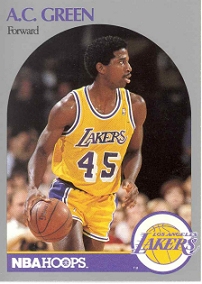 A.C. Green is a Portland, Oregon native. He starred at Benson Tech, leading the Techmen to a state basketball championship and earning the state player of the year, averaging 26 points per game. He was a starter for Oregon State from 1982 to 1985 and was selected to the freshman All Pac-10 team; a three-time All Pac-10 selection and the 1984 Pac-10 Player of the Year. In 1984, A.C. was the Region 8 Player of the Year and a third team All-America selection. A year later, in 1985, Green was a 1st round NBA selection by the Los Angeles Lakers, the 23rd pick overall. He broke the NBA's Iron Man record for consecutive games played (906) in 1997, and went on to establish the new standard of 1,192 straight games. A.C. earned a championship ring with the Los Angeles Lakers for the 1999-2000 season. He played 2 seasons with the Dallas Mavericks, 4 seasons with the Phoenix Suns and 8 seasons with the Lakers. His final season was with the Miami Heat in 2000-01. The NBA coaches selected him for the All Defensive second team in 1988-89 and he recorded a career high of 35 points in 1994. He was voted a starter for the NBA All-Star game in 1990. A.C. established the A.C. Green Foundation in 1989 with focus on sexual abstinence education. He was recently inducted into the World Sports Humanitarian Hall of Fame for excellence both on and off the court. A.C. and his wife Veronique were married in April 2002. A.C. is a youth mentor, author, speaker and successful businessman.
A.C. Green is a Portland, Oregon native. He starred at Benson Tech, leading the Techmen to a state basketball championship and earning the state player of the year, averaging 26 points per game. He was a starter for Oregon State from 1982 to 1985 and was selected to the freshman All Pac-10 team; a three-time All Pac-10 selection and the 1984 Pac-10 Player of the Year. In 1984, A.C. was the Region 8 Player of the Year and a third team All-America selection. A year later, in 1985, Green was a 1st round NBA selection by the Los Angeles Lakers, the 23rd pick overall. He broke the NBA's Iron Man record for consecutive games played (906) in 1997, and went on to establish the new standard of 1,192 straight games. A.C. earned a championship ring with the Los Angeles Lakers for the 1999-2000 season. He played 2 seasons with the Dallas Mavericks, 4 seasons with the Phoenix Suns and 8 seasons with the Lakers. His final season was with the Miami Heat in 2000-01. The NBA coaches selected him for the All Defensive second team in 1988-89 and he recorded a career high of 35 points in 1994. He was voted a starter for the NBA All-Star game in 1990. A.C. established the A.C. Green Foundation in 1989 with focus on sexual abstinence education. He was recently inducted into the World Sports Humanitarian Hall of Fame for excellence both on and off the court. A.C. and his wife Veronique were married in April 2002. A.C. is a youth mentor, author, speaker and successful businessman.
2004
- Katy Steding - Basketball
-
2004
 Katy Steding was a basketball star from 1982-86 at Lake Oswego High School, earning All-State and All-American honors, as well as Academic All-American recognition. She then played four years for Stanford, from 1986-90. She was on the Pacific-10 Conference all-star team four times (1987-90) and led the Cardinal to the NCAA championship in 1990.
Katy Steding was a basketball star from 1982-86 at Lake Oswego High School, earning All-State and All-American honors, as well as Academic All-American recognition. She then played four years for Stanford, from 1986-90. She was on the Pacific-10 Conference all-star team four times (1987-90) and led the Cardinal to the NCAA championship in 1990. Steding played professionally overseas in Japan and Spain in the early 1990s. She was a member of the U.S. national team and was part of the 1996 Olympic team that won the gold medal in the Atlanta Games. She then went on to play for the Portland Power of the American Basketball League in 1996-98 and for two WNBA teams, the Sacramento Monarchs (2000) and Seattle Storm (2001).
2006
- Terrell Brandon - Basketball
-
2006
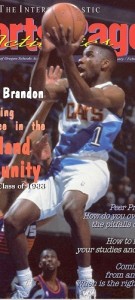 Terrell Brandon, a two-time NBA All-Star, grew up in Northeast Portland, not far from where he lives today. A standout player at Grand High School, in 1988 he was named Oregon High School Basketball Player of the Year and led his Grand Generals to the state title. He spent two years at the University of Oregon, where he set school and Pac-10 records in numerous categories, including scoring average, assists and steals in a single game and single season steals. After twice earning team MVP honors, he entered NBA the draft and was the 11th pick overall, going to the Cleveland Cavaliers.
Terrell Brandon, a two-time NBA All-Star, grew up in Northeast Portland, not far from where he lives today. A standout player at Grand High School, in 1988 he was named Oregon High School Basketball Player of the Year and led his Grand Generals to the state title. He spent two years at the University of Oregon, where he set school and Pac-10 records in numerous categories, including scoring average, assists and steals in a single game and single season steals. After twice earning team MVP honors, he entered NBA the draft and was the 11th pick overall, going to the Cleveland Cavaliers.In 1992 he was named to the NBA All-Rookie Second Team. His career spanned more than a decade, playing Cleveland, Milwaukee and Minnesota. He was selected for the NBA All-Star game twice and was the winner of the 1996-97 NBA Sportsmanship Award. He set a franchise single_season record for rebounds by a point guard (3.8 rpg) with Minnesota before retiring after 2001-02 season.
He now lives in Portland and is active in the community in which he was raised. His company, Tee Bee Enterprises, operates a number of businesses in Northeast Portland as well as a monthly publication devoted to urban issues. His foundation also reflects his desire to give back, staging a one-day basketball and entertainment tribute to Dr. Martin Luther King Jr.
In 1992, he was inducted into the PIL Hall of Fame.
2008
- Jerome Kersey - Basketball
-
2008
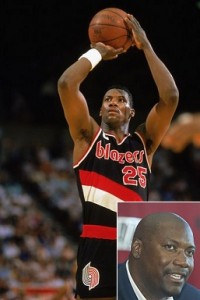 Jerome Kersey came to the Portland Trail Blazers from Longwood College, an NCAA Division II school, where he set school records for points, rebounds, steals, and blocked shots, with a 57% shooting record. Portland selected him in the 1984 NBA draft and he immediately became a regular contributor off the bench. Hitting his stride in his third year with the Blazers, he became a starter, and was part of the nucleus of a strong Portland team , along with Clyde Drexler and Terry Porter that made it to the NBA Finals two out of the next three years (1990 and 1992).
Jerome Kersey came to the Portland Trail Blazers from Longwood College, an NCAA Division II school, where he set school records for points, rebounds, steals, and blocked shots, with a 57% shooting record. Portland selected him in the 1984 NBA draft and he immediately became a regular contributor off the bench. Hitting his stride in his third year with the Blazers, he became a starter, and was part of the nucleus of a strong Portland team , along with Clyde Drexler and Terry Porter that made it to the NBA Finals two out of the next three years (1990 and 1992).As a Trail Blazer, Jerome was near the top in many of Portland’s career categories at the time, including games played (second), minutes (third), scoring (third), rebounding (second), assists (sixth), steals (third), field goals (fourth), and blocked shots (second).
In more recent years, Kersey was hired by the Trail Blazers to serve as director of player programs during the 2003-04 NBA season. He then rejoined his former teammate, Terry Porter as assistant coach with the Milwaukee Bucks.
In November 2005, Jerome Kersey entered Longwood’s first Hall of Fame class, and this past year, was inducted into the Virginia Sports Hall of Fame.
2009
- Gary Payton - Basketball
-
2009
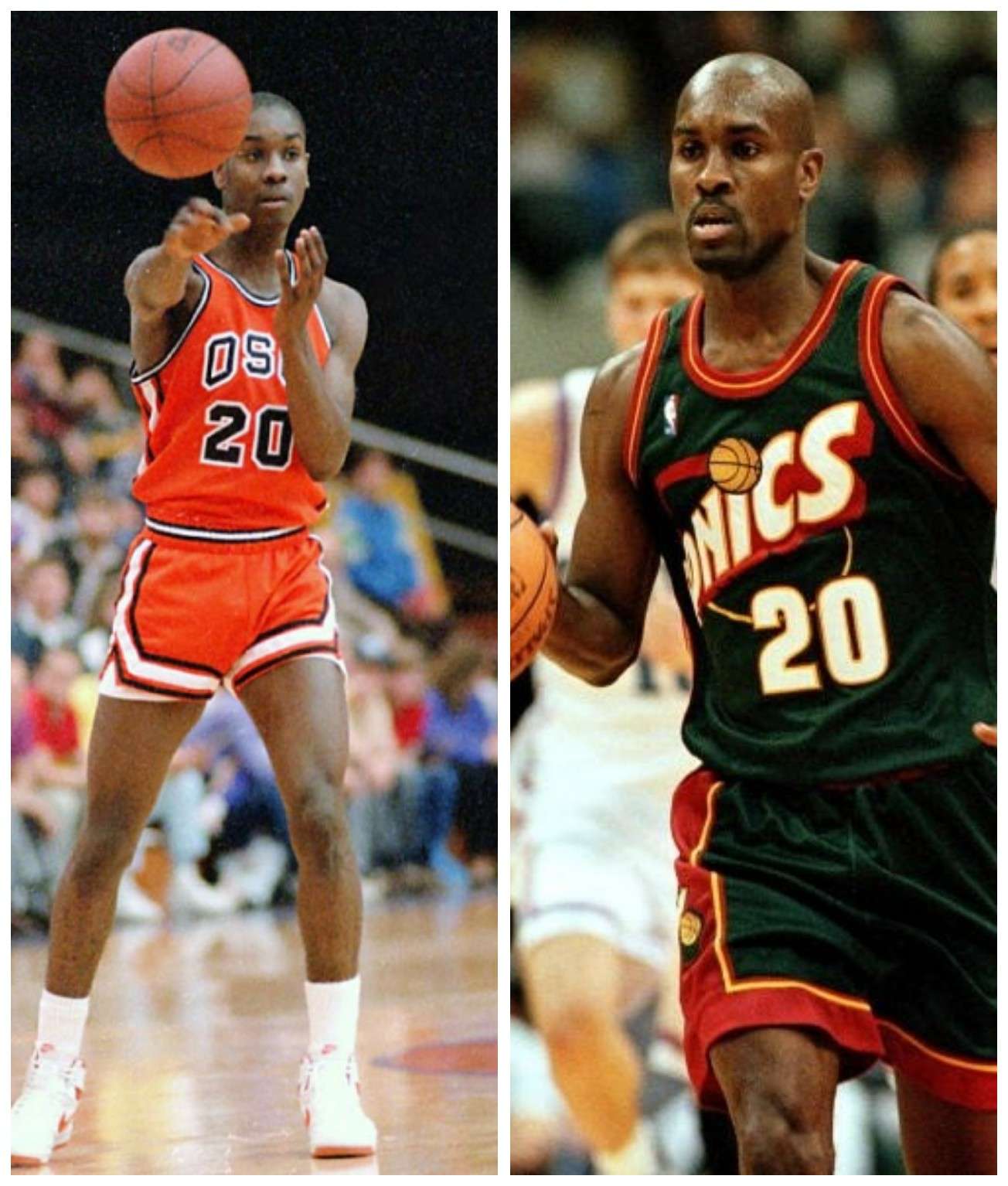 "The Glove” spent just a short time in Oregon, but endeared himself to always be remembered as someone who made the state great.
"The Glove” spent just a short time in Oregon, but endeared himself to always be remembered as someone who made the state great.
Payton grew up in Oakland, Calif., then made his way to Corvallis and Oregon State, where he played under legendary coach Ralph Miller from 1986 to ‘90. In his days there, he developed a reputation as a defensive genius, and his overall game earned him the NCAA Player of the Year honor in 1990. During that time, the Beavers played in the NCAA Tournament three times, and became one of the nation’s top teams. The Beavers won the Pac-10 title in 1990, and he was named Sports Illustrated’s Player of the Year that season. He set OSU records for scoring, assists and steals.In 1990, the Seattle SuperSonics made Payton the second pick in the NBA Draft. Payton played 13 seasons in Seattle before moving to the Milwaukee Bucks for the 2003 season. He played two seasons for the Los Angeles Lakers, two for the Boston Celtics, then three seasons with the Miami Heat, where he won an NBA title in 2006.
Payton made the NBA All-Star Game nine times, and was an All-NBA selection nine times. USA Basketball named him Player of the Year in 1999, and he won two Gold Medals on the Olympic Team once professional players were admitted in 1996.
During his career in the NBA, Payton finished in the Top 10 all-time in games, and minutes played and with a scoring average of 16.3 points per game. He was inducted to the NBA Hall of Fame in 2013. Oregon State inducted him to its Hall of Fame, and retired his No. 20.
2010
- Terry Porter - Basketball
-
2010
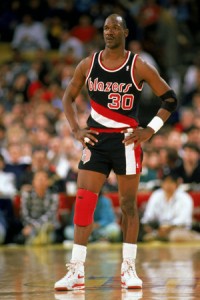 Terry Porter arrived in Oregon from a small midwestern school, but quickly became one of the Portland Trail Blazers’ most popular players during the era when the team reached the NBA Finals twice.
Terry Porter arrived in Oregon from a small midwestern school, but quickly became one of the Portland Trail Blazers’ most popular players during the era when the team reached the NBA Finals twice.Born in 1963, Porter grew up in Milwaukee, Wisc., and played collegiately at Wisconsin-Stevens Point, an NCAA Div. III school. Despite the small size of the school, Porter grew to be a 6-foot-3 point guard, and the Blazers drafted him No. 24 overall in 1985.
In 10 seasons with the Blazers, Porter quarterbacked a roster that included Clyde Drexler and established a franchise record for assists: 5,319. He played in two All-Star Games (1991, ’93), played in the 1990 and ’92 NBA Finals and received the J. Walter Kennedy Citizenship Award in 1993.
Porter moved from the Blazers to the Minnesota Timberwolves in 1995 and also played for the Miami Heat and San Antonio Spurs before retiring in 2002. In 17 seasons, he averaged 12.2 points and 5.6 assists per game.
Porter moved into coaching following his playing career and became head coach of the Milwaukee Bucks after just one season as an assistant in Sacramento.
Porter was inducted to the Oregon Sports Hall of Fame in 2010, two years after the Blazers retired his number, 30.
2013
- Lindsey Yamasaki - Basketball
-
2013
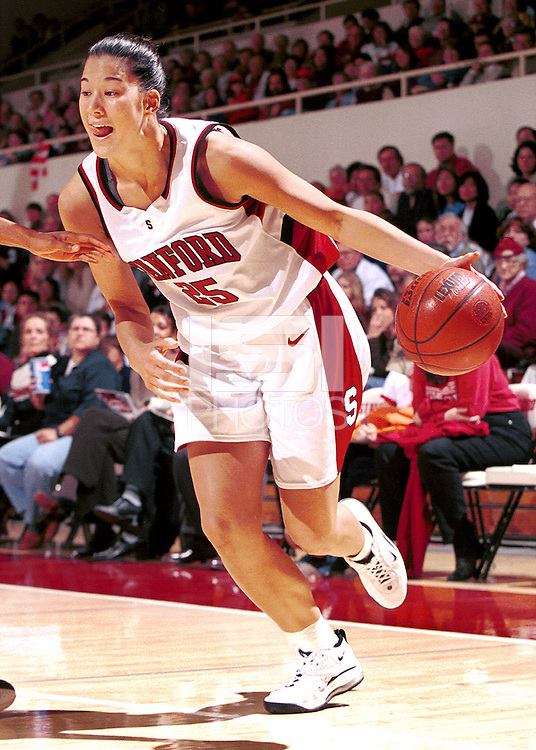 A native of Oregon City, Lindsey Yamasaki might be from a small town, but she’s accomplished some big-time goals.
A native of Oregon City, Lindsey Yamasaki might be from a small town, but she’s accomplished some big-time goals.During her time at Oregon City High School, she led the team to four consecutive State Championships and was unanimously selected as a senior First Team All-American by USA Today, Nike, the Women’s Basketball Coaches Association, Street & Smith’s SportsBusiness Journal, and Parade magazine… just to name a few.
Also as a senior, she was named as Gatorade’s Oregon Player of the Year for both basketball and volleyball. And like all athletes dream of, Lindsey made her way into Sports Illustrated magazine as the Old Spice Athlete of the Month for March, 1998.
With such power and versatility, Lindsey was one of the top recruits out of high school, ultimately heading to Stanford University on a full scholarship. There, she helped the Cardinal to four NCAA Tournament appearances and earned All-Pac-10 awards before going on to play professionally in Europe and the WNBA.
Through Lindsey’s great success, she’s remained humble and incredibly close with her family. She went on to coach basketball, and now takes charge in the business world as a Principal at a premier executive search firm in San Francisco.
2015
- Damon Stoudamire - Basketball
-
2015
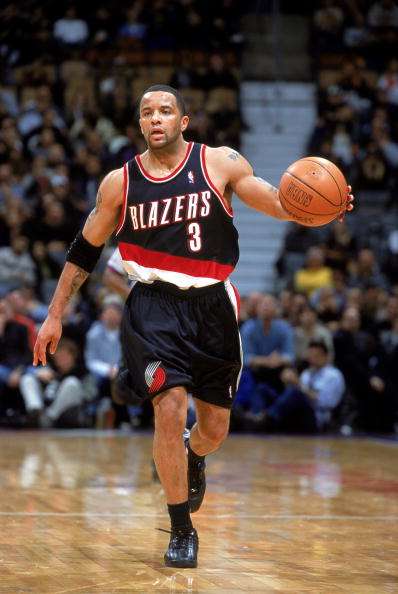
Damon Stoudamire grew up in Southwest Portland and a household name among Oregonians throughout high school, college and a lengthy NBA career that included seven seasons as a Trail Blazers.
Stoudamire became a standout almost immediately at Wilson High School - the son of Portland State great Willie Stoudamire. Raised primarily by his uncles, Charles and Anthony, he led Wilson to state titles in 1989 and ‘91, and eventually moved to the University of Arizona program. He helped the Wildcats to the NCAA Final Four in 1994, and was co-Player of the Year in the Pac-10 in 1995. Later that year, the expansion Toronto Raptors selected him with the seventh pick overall, and he set an NBA record for 3-point shots made by a rookie. He earned the Rookie of the Year award, and earned the nickname “Mighty Mouse” due to his size, 5-foot-10, and Mighty Mouse tattoo which he got on his right arm prior to his rookie season. Damon played three seasons for the Raptors before being traded to the Blazers in 1998.Returning to Portland as the team’s point guard, Damon led the Blazers to the Western Conference Finals in 1999, and set a team record for points scored in a game with 54 in 2004. He played with the team through 2005, when he moved to the Memphis Grizzlies during the summer. He also played for the San Antonio Spurs in 2008 before retiring having averaged 13.4 points and 6. 1 assists per game over 13 seasons.
Damon quickly became an assistant coach at both the college and professional ranks, and was hired at the head coach at University of the Pacific in 2016.